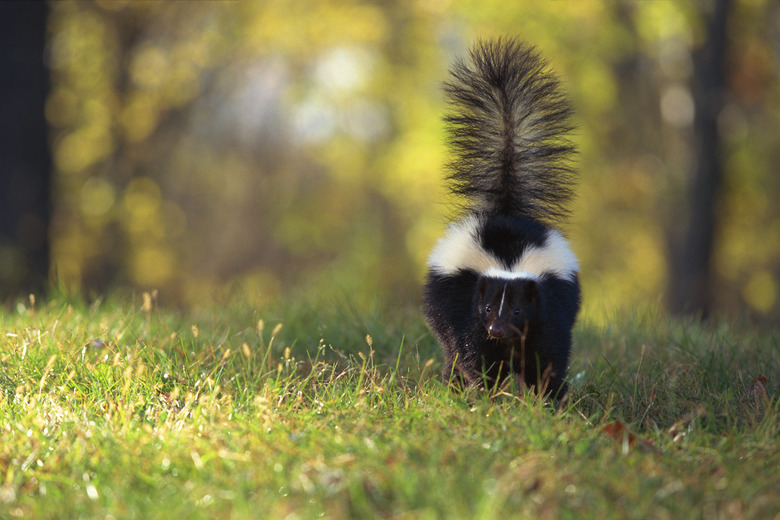The Colors Of Skunks
Most people recognize the black and white pattern of typical striped skunks. For the most part, so do other animals.
Studies suggest that the distinct black and white pattern serves as a warning signal to other animals, like the bright colors of poison arrow frogs and the yellow and black stripes of many bees and wasps. But not all skunks have the same black and white patterns.
Read more about the physical and behavioral adaptions of skunks.
Skunk Colors: Black and White (Mostly)
Skunk Colors: Black and White (Mostly)
Of the twelve species of skunks, nine species reside in the Western hemisphere. Skunks in the Western hemisphere are predominantly black and white, but the patterns of their colors vary.
Striped and Hooded Skunks (Genus Mephitis)
Striped and Hooded Skunks (Genus Mephitis)
Striped skunks, Mephitis mephitis, are probably the most familiar skunk pattern. Striped skunks have shiny black fur with two white stripes flanking their spine. Typically, the stripes begin as one stripe between their ears, splits to form the double stripe down their backs, then combines again to form one stripe down the center of their tails. Striped Skunks also have a little white stripe between their eyes.
Typical doesn't mean always, however. Variations of color within the striped skunk population range from all black skunks to, very rarely, solid white skunks. The Eastern striped skunk also may be brown with white stripes.
To tell if an apparently white skunk animal is an albino or an all-white color variant, look at the eyes. An albino, whether skunk or another animal, lacks the genetic trigger for pigmentation, and so the eyes will be red. A white skunk color variant will have black eyes. Check out white skunk pictures online.
Hooded skunks, Mephitis macroura, differ from striped skunks in that their tails are longer, they have tufts of fur around their necks, and (according to brave sources) their fur is softer. Hooded skunks may have stripes like striped skunks, but they also may have narrow stripes or a single wide stripe up their backs with a white tail.
Spotted Skunks (Genus Spilogale)
Spotted Skunks (Genus Spilogale)
Spotted skunks have black and white patterns of broken stripes and spots rather than the distinct stripes of the striped skunk. Western spotted skunks have larger spots and stripes than Eastern spotted skunks.
Pygmy spotted skunks, found along the Pacific coast in southern Mexico, are the smallest skunks. Spotted skunks are smaller than striped skunks.
Hog-Nosed Skunks (Genus Conepatus)
Hog-Nosed Skunks (Genus Conepatus)
Hog-nosed skunks, found in Texas and Mexico, are the largest North American skunks, growing to about 3 feet long. Their black-and-white pattern typically shows one very wide white stripe running from the top of the head all the way to the tip of the almost completely white tail.
These skunks could be described as a white skunk with black stripes along their sides. Hog-nosed skunks have a prominent bare nose they use to plow up ground looking for insects, bringing them the nickname of "rooter" skunks.
The hog-nosed skunks of Central and South America are smaller than their North American relatives. These southern hog-nosed skunks have black and white patterns more like striped skunks, but they lack the small white stripe between their eyes.
Stink Badgers (Genus Mydaus)
Stink Badgers (Genus Mydaus)
DNA testing in the 1990s reclassified stink badgers as skunks. These Old-World skunks are found in the Philippines, Malaysia and Indonesia.
They resemble hog-nosed skunks with a bobbed tail. Their white markings, however, can be missing, a single narrow line or a double line.
Breeding Skunk Colors and Patterns
Breeding Skunk Colors and Patterns
While skunks might not be everyone's first choice, breeders and enthusiasts take pride in their pets. As with other animals, enthusiasts use selective breeding to perpetuate unusual patterns and colors.
Chip, swirl, star and falling star are some of the unusual fur variations of the classic striped pattern. Besides solid white skunks, unusual colors include champagne (blonde), chocolate (brown), smoke (gray), mahogany (red brown), apricot (tan, orange) and lavender (white with faint purplish tint).
Warning
Legal restrictions impact pet skunk ownership in most states.
References
- Texas Tech University – Natural Science Research Laboratory: Common Hog-nosed Skunk
- University of Michigan Museum of Zoology – Animal Diversity Web: Striped Skunk
- South Carolina Department of Natural Resources: Eastern Spotted Skunk
- Montana's Official State Website: Montana Field Guide — Western Spotted Skunk
- Animal Diversity Web: Mephitis mephitis – Striped Skunk
- Pennsylvania State University: Species Pages – Mephitis mephitis
- Encyclopaedia Britannica: Skunk
- Mom.me: Types of White Skunks
- The Animal Files: Pygmy Spotted Skunk
- Skunk Guru: Skunk Colours and Patterns
- Terminix: How to Identify Different Types of Skunks
Cite This Article
MLA
Blaettler, Karen G. "The Colors Of Skunks" sciencing.com, https://www.sciencing.com/colors-skunks-8686827/. 22 November 2019.
APA
Blaettler, Karen G. (2019, November 22). The Colors Of Skunks. sciencing.com. Retrieved from https://www.sciencing.com/colors-skunks-8686827/
Chicago
Blaettler, Karen G. The Colors Of Skunks last modified March 24, 2022. https://www.sciencing.com/colors-skunks-8686827/
